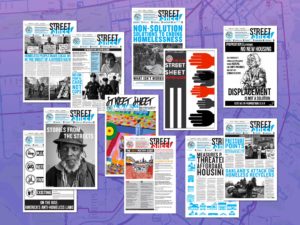by Cathleen Williams

All of the material things that belong to Stephanie Arnold Williams fit on two small shelves in her dwelling place on the sidewalk of East Sixth Street in Los Angeles. She lives here under an airy, white tent; she is building a sleeping platform next door. Stephanie has set up this tiny oasis, clean and cool, outside the sturdy cement block building that houses LA Community Action Network (LA CAN) in the heart of Skid Row.
LA CAN organizes, mobilizes, and serves the thousands of unhoused people who struggle to survive on the surrounding streets, living always under the threat of police- driven displacement, arrest, and incarceration, as well as the raw hardship of exposure to LA’s relentless heat and sudden drenching rains.
Stephanie Williams—who is not related to this story’s author—is famous in her neighborhood, where she was long known as the “Queen of Skid Row.” After she arrived here in 2013, she witnessed the violence of the LA Police Department when they shot and killed an unarmed Black homeless man in his tent, Charley “Africa” Keunang, in 2015. Eventually the police were found liable for his death and had to pay the family millions. As she later told LA Magazine, “That moment was when I decided that I needed to be a full-time freedom fighter … to come here and record the police and see what they’re doing.”
“So, here’s what I did,” she tells me as we sit together in the shade of her tent on a hot afternoon in September. “I set up the White House Community Center at Fifth and San Pedro. A challenge to the White House in Washington to show how it should be done.” Stephanie established a 60-foot tent on a wheeled platform, with couches, tents, solar charging, hygiene—especially for women—an inflatable jacuzzi for relief and refreshment, a microwave, and a sewing machine. It provided a safe haven for the neighborhood for years, a place to rest in the shade, a hub for dropping off food, socks, hygiene, love, hugs and support. “We offered housing resources in a tiny house right next door—we called it ‘Housing for Health’—and referrals to all sorts of housing and services. We offered one-on-one counseling, even if it took a year to help get people on their feet.”
On February 13, 2023, LA Sanitation destroyed the White House after giving Stephanie only 30 minutes’ warning to “move her stuff.” As police stood guard and a horrified crowd cried out in protest, a giant claw ripped into the fragile structure and tossed what remained into an open truck, even as tents across the street were left unmolested. LA Sanitation later falsely claimed the destruction was routine and that Stephanie’s belongings were saved and stored—despite clear evidence to the contrary. No official has ever explained why Stephanie was targeted.
“There is no routine, no regular schedule,” Stephanie points out. “The City picks and chooses, tricks and schemes. The White House rolled on wheels. I told them I could move it. It was the cleanest place in Skid Row—I used a power wash machine.” As she explained, “I was targeted because I am a voice for the community, and because I set up a camera to show how the City was terrorizing the homeless.”
The demolition of the White House made not only local but also international news.
Stephanie now envisions the White House rising again from the dirt and debris. She sketches further plans for a wellness center, a “self-healing” hospital, and an organic garden. As she explains, “Now I’m on the sidewalk. Yesterday a man came by who lost the apartment he’d had for ten years. He just needed to lie down. I can offer this. He lay down here. I offer whatever I can, depending on the need.”
In her daily contacts, Stephanie sends a straightforward message, explaining that we need tiny houses now that the residents can manage, on the sidewalk, because we don’t have anywhere else to put them. “Bring the truck, bring brooms and supplies, let us clean up. Otherwise leave the homeless alone.” As she says, the tiny homes would beautify Skid Row and make it a better place for the homeless to live. They would be able to walk away, lock their door and run their errands.
“A lot of people are lying on the ground,” Stephanie says. “They say everyone don’t qualify to lay their head down. I say, you have to have a place to lay your head down, no matter who you are. They say the homeless do not qualify to lay their head down. I say, housing is a human right!”
She left me with these closing words. “It’s time to get up and fight. I live off the land, I don’t accept money. Skid Row takes care of me. One blanket, one towel, one pair of shoes … I’m not leaving until all the homeless are off the ground.”
###

